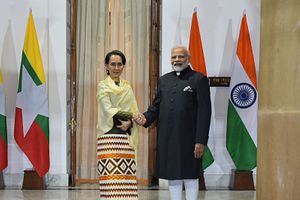The recent opening of two land-border crossings between India and Myanmar at Tamu/Moreh in the state of Manipur and Rihkhawdar-Zowkhawtar in Mizoram will go a long way toward bringing India and Myanmar closer.
According to a statement issued by the Indian Embassy in Myanmar, “the landmark Land Border Crossing Agreement between India and Myanmar, signed on May 11, 2018, has been brought into effect with the simultaneous opening of international entry-exit checkpoints at the Tamu-Moreh and the Rihkhawdar-Zowkhawtar border between Myanmar and India.”
Why is this crucial for India’s “Act-East Policy”?
First, Myanmar shares an almost 1,600km border with four Northeast Indian states: Arunachal Pradesh, Nagaland, Manipur, and Mizoram. Many of the people who live in these provinces of India have brethren living across the border in Myanmar (like in the case of the Nagas of Nagaland).
Second, Myanmar is crucial for New Delhi’s connectivity initiatives in the region, particularly in light of its non-participation in the Beijing-led Belt and Road Initiative. India, Myanmar, and Thailand are working on the trilateral India-Myanmar-Thailand highway, which is expected to be see completion by the end of next year. There are also plans to connect it with pre-existing highways all the way to Da Nang in Vietnam.
Third, this will give a leg-up to the Indian involvement in Myanmar, especially in the field of infrastructure, where Beijing seems to have stolen a march over New Delhi. The India-funded Kaladan Multi-Modal Transit Transport Project, which will allow for sea-access for the landlocked Northeastern states of India via the Kaladan river in Myanmar, has been plagued by delays. The opening of the land routes will strengthen New Delhi’s case when it comes to the actual delivery of projects and initiatives.
Meanwhile, the Narendra Modi government after taking office in India in 2014 had renamed the “Look-East Policy” as the “Act-East Policy.” The central government, in concert with the state governments, has also been given a big push to infrastructure development in the Northeastern region. In May last year, Modi inaugurated the Bhupen Hazarika Setu bridge in Assam, which connects upper Assam and the eastern reaches of the border state of Arunachal Pradesh. At 9.15 km across, this bridge is India’s longest bridge.
Fourth, the opening of these land border crossings will help in the growth of tourism in Northeast India and Myanmar. The Northeastern states are strikingly beautiful and many people in Myanmar and other ASEAN nations in the future could visit the Northeast Indian states.
Fifth, this will help in the growth of medical tourism in the Northeastern states of the country, which offer high quality medical services at reasonable rates, something which may interest people living in the border regions of Myanmar.
Finally, the opening of these land routes also reflects the rapid growth in India-ASEAN ties, which was exemplified by the presence of the heads of state of all the ASEAN states at India’s Republic Day celebrations earlier in January this year for the ASEAN-India commemorative summit.
Relations have indeed moved a long way since 1992 when New Delhi became a sectoral dialogue partner of ASEAN. Steps like these will aid India’s outreach to the ASEAN countries. Myanmar is India’s land bridge to ASEAN and hence closer connectivity with Myanmar is sine qua non for the success of India’s “Act-East Policy.”
Rupakjyoti Borah is with the Institute of South Asian Studies at the National University of Singapore. The views expressed are personal. He can be reached at rupakj@gmail.com or via Twitter @rupakj.

































